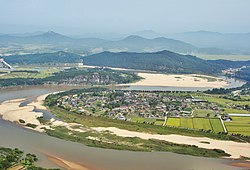
Back آندونغ Arabic Andong BCL Андонг Bulgarian Andong Catalan Andong (lungsod) CEB Andong Czech Andong German Andon Esperanto Andong Spanish Andong Estonian
Andong
안동시 | |
|---|---|
| Korean transcription(s) | |
| • Hangul | 안동시 |
| • Hanja | 安東市 |
| • Revised Romanization | Andong-si |
| • McCune–Reischauer | Andong-si |
 An aerial view of Hahoe Folk Village | |
 Location in South Korea | |
| Coordinates: 36°33′33″N 128°43′44″E / 36.55917°N 128.72889°E | |
| Country | |
| Region | Yeongnam |
| First mention | 930 |
| City status | 1963 |
| Administrative divisions | 1 eup, 13 myeon, 10 dong |
| Government | |
| • mayor | Ki Chang Kwon (권기창) |
| Area | |
| • Total | 1,590.91 km2 (614.25 sq mi) |
| Elevation | 139 m (456 ft) |
| Population (September 2024[1]) | |
| • Total | 153,348 |
| • Density | 96/km2 (250/sq mi) |
| • Dialect | Gyeongsang |
| Demonym | Andongite |
| Time zone | UTC+9 (Korea Standard Time) |
| Postal code | 760003-760944 |
| Area code | (+82) 054 |
| Website | Official website |
Andong (Korean: 안동; Korean pronunciation: [an.doŋ]) is a city in South Korea, and the capital of North Gyeongsang Province. It is the largest city in the northern part of the province with a population of 167,821 as of October 2010. The Nakdong River flows through the city. Andong is a market centre for the surrounding agricultural areas.
Since the 1970s Andong has developed rapidly, although the population has fallen by nearly seventy thousand as people have moved away to Seoul, Busan, Daegu and other urban centres. In the late 1990s and early 2000s it became a tourism and cultural center.
Andong is known as a centre of culture and folk traditions. The surrounding area maintains many types of traditions and the Andong Folk Festival is held in mid October every year. One of the most famous aspects of these cultural festivities are the Andong masks.
Andong National University, specialising in education and Korean folklore, has grown rapidly since the 1970s. Other tertiary institutions include Andong Science College and Catholic Sangji College.
- ^ "Population statistics". Korea Ministry of the Interior and Safety. 2024.

